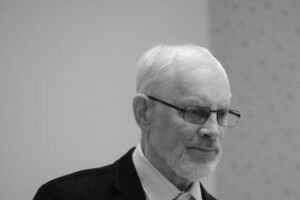Vytautas Martinkus

Photo by Vladas Braziūnas
Vytautas Martinkus (born 1943) represents the generation of Lithuanian writers whose biographies reflect their complicated times and mixed loyalties. He first trained as an engineer in the 1960s, and started writing short stories around the same time (first collection published 1969). He switched to philosophy, a much more politicized field, and earned his PhD in 1981. He taught philosophy at the university and joined the Communist Party in 1977. He became involved in various leadership roles in the Writers’ Union still during the Soviet times, and he was the Chair in 1990-91, the years of the greatest political upheaval. He remained a university professor after the Independence, and was awarded major literary prizes from both Soviet Lithuania and the Independent Republic (including the National Prize in 2018).
Philosophy and history have been important themes throughout his literary career. Less so engineering, even though one of his novels is a fictionalized biography of the father of Lithuanian aviation Aleksandras Griškevičius.
Tavo bažnyčios rūsys (The Crypt of Your Church). Vilnius: Lietuvos rašytojų sąjungos leidykla, 2018, – 512 p. The 500 pages of the novel span around 500 years of Lithuanian history and its curiosities, fixed around the axis of two rings with precious stones, one ancient and regal, the other copied by a talented alchemist. The rings are passed on, given as gifts, offered in marriage proposals, lost and stolen, whereas their ever changing owners represent a gallery of characters from all walks of life and historical times. The book is structured in four parts, representing the four elements as understood by alchemy. The narrators are speaking in appropriately different voices, a strength of the novel that almost all the reviewers compliment. One might say the concept of ethnic Lithuanian identity feels a little too romantic, probably old-fashioned, however, the mythological, religious, archetypal dimensions as well as historical research definitely provide for a rich reading experience.